St Lucia
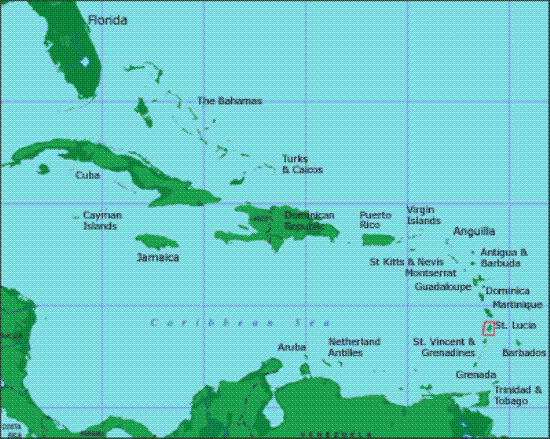
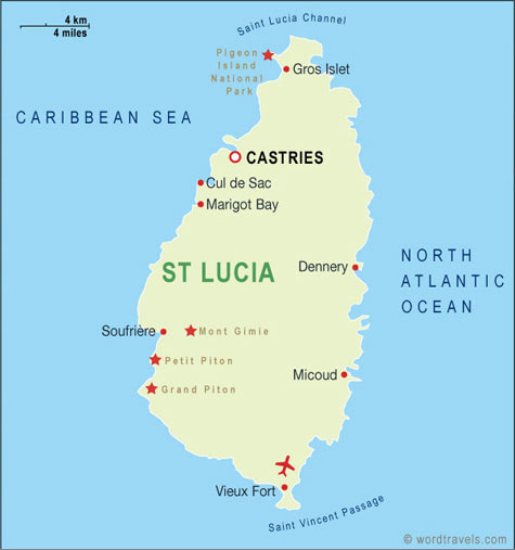
Saint Lucia (pronounced Saint Loo Sha) is an island
nation
in the eastern Caribbean Sea on the boundary with
the Atlantic Ocean. Part of the Lesser
Antilles, it is located north/northeast of the
islands of Saint Vincent and the Grenadines, northwest of Barbados and south of Martinique. Its size is 620 km² with an estimated population of
160,000. Its capital is Castries. Saint Lucia is one of the Windward
Islands, named for Saint Lucy of
Syracuse. It was first visited by Europeans in about
the year 1500 and first colonized successfully by France who signed a treaty with the native
Carib peoples in 1660. Great
Britain took control of the island from 1663 to 1667
then went to war with France over it fourteen times, and finally took complete
control in 1814. Because it switched so often between British and French
control, Lucia was also known as the "Helen of the West Indies" as it was
likened to the mythical Helen of Troy. Representative government came about in 1924 (with
universal adult suffrage from 1953) and from
1958 to 1962 the island was a member of the Federation of the West
Indies. Finally, on February
22, 1979, Saint Lucia became an independent state of the
Commonwealth of Nations. The island nation
celebrates this every year with a public holiday.

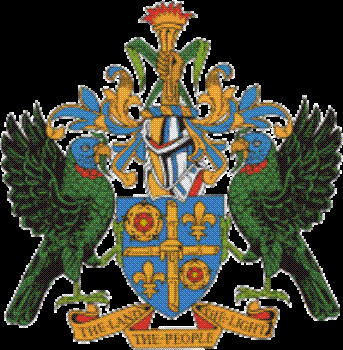
The National Flag of St Lucia and the
Coat of Arms.
Politics. As a
Commonwealth realm, Saint Lucia recognizes Queen
Elizabeth II as the Head of
State of Saint Lucia, represented on the island by
a Governor-General. Executive
power, however, is in the hands of the prime
minister and his
cabinet. The prime minister is normally the head of
the party winning the elections for the House of Assembly, which has 17 seats. The other chamber of
Parliament, the
Senate has 11 appointed members. Saint Lucia is a
full and participating member of the Caribbean Community
(CARICOM) and the Organisation of Eastern Caribbean
States (OECS).
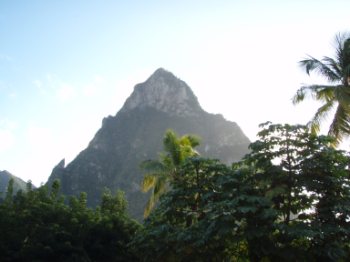


The famous Piton, a bay in the south and a confusing place actually called
Cul-de-Sac.
Geography.
The
volcanic island of Saint Lucia is more mountainous than many
other Caribbean islands, with the highest point being Mount
Gimie, at 950 metres (3,120 ft) above sea level. Two other mountains, the
Pitons, form the island's most famous landmark. They are located between
Soufriere and Chioseul on the western side of the
island. Saint Lucia is also one of the few islands in the world that boasts a
drive-in volcano. The capital city of Saint Lucia is
Castries, where about one third of the population lives. Major
towns include Gros Islet (just above where we are), Soufriere (one of
the most photographed bays in the world) and Vieux Fort (where the international
airport is). The local climate is
tropical, moderated by northeast trade
winds, with a dry season from January to April and a rainy season from May
to December.
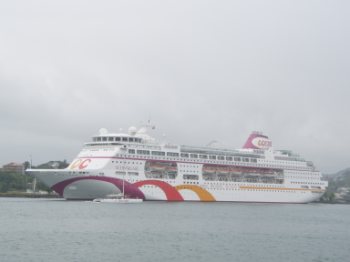


The cruise ship 'Ocean Village'. A chap I liked and a fish stall
in Castries we stopped at and bought a Mahi-Mahi, three pound in weight for
£7.00.
Demographics. The population of Saint Lucia is of mostly
African descent (82.5% of the population). There is also a
significant Mixed minority representing 11.9%, with
Indo-Caribbean or Indian groups at 2.4% and the small
European origin minority (descendants of French, British, and Irish colonists).
Other or unspecified ethnicity accounts for 3.1%. There are small numbers of
Lebanese, Syrians and Chinese. The official language is
English, but a Creole language called Antillean
Creole is spoken by 80% of the population and is getting increasing usage
and official recognition. It evolved from French patois, African
languages, and Carib. Saint Lucia is a member of
La Francophonie. St. Lucia boasts the highest ratio in the
world for number of Nobel laureates produced with respect to the total
population of the nation. Two winners have come from St. Lucia: Sir Arthur
Lewis won the Nobel Prize in Economics in 1979, and Derek
Walcott received the Nobel Prize in
Literature in 1992. Both were born on January 23rd, but in
different years.
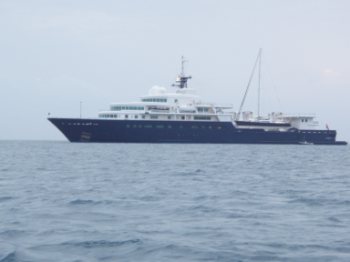
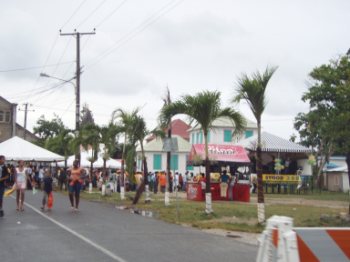
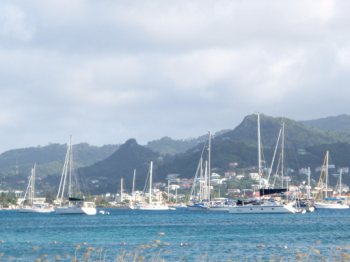
A very posy visitor in this yacht that is
over 300 feet in length (owned by a German gentleman), it has a yacht the same
size as Beez Neez, see in the photo, on the other side of this is a power boat
of similar size. We drove through Gros Islet on Sunday and there was a Catholic Synod meeting being held, you don't get them with
a full steel band in the UK. Rodney Bay is very
popular with yachties, free to anchor and welcoming port for the ARC
Rally.
Religion. About 70% of the population is Roman
Catholic. The rest are Seventh-day
Adventists (7%), Pentecostalists (6%),
Anglicans (2%), Evangelicals (2%) and
Rastafari (2%), we have also seen several large meeting places of
the Jehovah Witnesses.
Migration from Saint Lucia is primarily to
Anglophone countries, with the UK) having almost
10,000 Saint Lucian born citizens, and over 30,000 of Saint Lucian heritage. The
second most popular destination for Saint Lucian expatriates is the
US, where combined (foreign and national born Saint Lucians) almost
14,000 reside. Canada is home to a few thousand Saint Lucians,
while most other countries in the world have less than 50 citizens of Saint
Lucian origin (the exceptions being Spain and
France with 124 and 117 Saint Lucian expats
respectively).

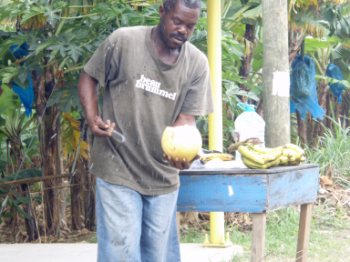

We had to do the fresh coconut bit.
Machetes here are not seen as weapons, they are tools and this chap was very
experienced at topping out and serving with a straw, two cost about 40p. Bear
thought inside they were the brown ones you hit at a coconut shy - wrong, these
are only good for their juice.
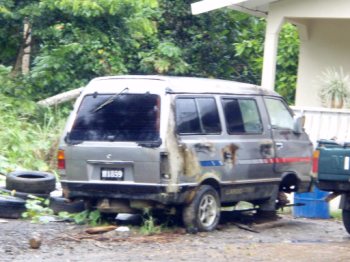

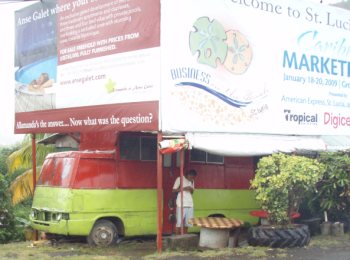
Some for the "One careful owner" series
that has become so popular, but I was shocked to see one with an advertising
hording growing out of it.
Festivals. The culture of Saint Lucia has been
influenced by African, French and English heritage. Cultural festivals include
La Rose and La Marguerite, the one representing the
Rosicrucian order, the other one representing
Freemasonry, which can be seen on a mural painted by Dunstan St.
Omer, depicting the Holy Trinity of
Osiris, Horus and Isis. Traditionally, in common with other
Caribbean countries, Saint Lucia held a carnival before Lent but
in 1999, it was moved to mid-July in order to not to coincide with the
much larger Trinidad and Tobago carnival, so as to attract more overseas
visitors.
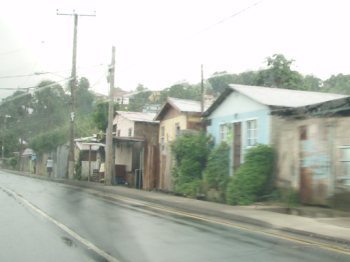


Castries. Is the capital city, has a
shanty, port, small airport and a big shopping mall and some very nice
houses.
Music and dance. A popular folk dance is the Quadrille.
As well as other Caribbean music genres such as soca, zouk, kompa and
reggae, Saint Lucia has a strong indigenous folk music tradition. Each May
since 1992, Saint Lucia has hosted an internationally-renowned Jazz Festival on
Pigeon Island. Everywhere we go we hear Country and Western playing, so they
love that too.

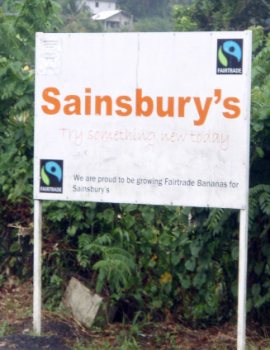

A vast amount of bananas are grown, mostly
we saw them down the east coast. A Sainsbury's sign,
I first thought was telling us there was a store here, looking closer Bear
pointed out it was telling us it was a 'fair trade'
grower.
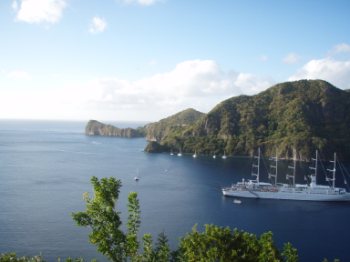


Tourism is vital to St. Lucia's economy and the economic
importance of such is expected to continue to increase as the market for bananas
becomes more competitive. Tourism tends to be more substantial during the dry
season (January to April) and tends to be popular due to its tropical weather
and scenery and its large number of beaches and resorts. Other tourist
attractions include the world's only drive-in volcano, Sulphur
Springs (at Soufriere), the
Botanical Gardens, the rain forests and Pigeon Island National Park,
which is home to Fort Rodney, an old British military base. The majority of
tourists visit St. Lucia as part of a cruise. Most of their time tends to be
spent in Castries, although Soufriere, Marigot Bay and Gros
Islet are popular locations to visit. We have spoken to quite a few
such cruisers, they tend to disembark at 9:30 and have to be on board for a
17:30 departure.
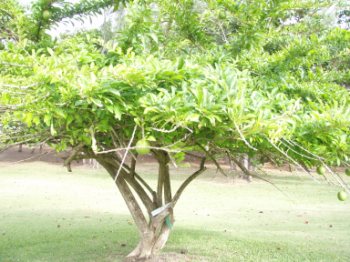
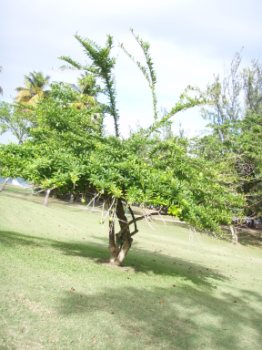

National Symbol is the Calabash
Tree (crescentia, huingo, krabasi, or kalebas, not to be confused with
the calabash vine) is a genus of six species of flowering
plants in the family Bignoniaceae, native to southern
Florida, the Caribbean, southern Mexico, Central America and northern South
America. The jaunty
angle in the second photo proves too many rum punches is bad for your
horizon. The species are small trees growing to 10 meters, and producing large
spherical fruits up to half a meter in diameter. St
Lucia sees the Frigate bird nesting and has its own
parrot.
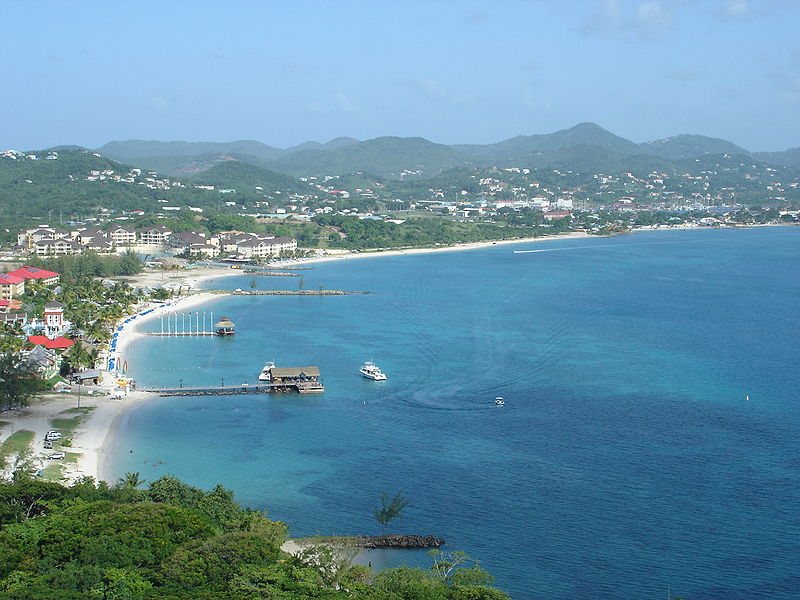
Photo from the top of Pigeon Island, in the north of Rodney Bay. The red roofs on the left belong to one of the
St Lucian Sandals Hotels. The fawn and brown buildings above Sandals is the
highly acclaimed Landings, we met Pam and Gary Lenden, their daughters Charlotte
and Helena, and Pam's parents there. They have a fabulous three bed roomed
apartment and treated us to lunch at the sea side restaurant, thank
you for a lovely day. Very tempting to chop our Sutton Harbour apartment for one
here. We are in the marina, seen top right.
All in all a really
lovely, friendly island, and the
weather isn't half bad either.
































